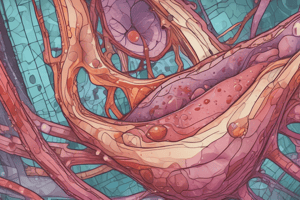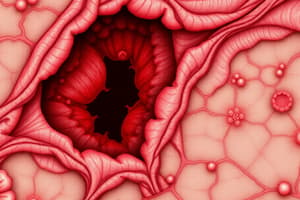Podcast
Questions and Answers
What is meant by wound?
What is meant by wound?
A cut or break in the continuity of any tissue, caused by injury or operation, often associated by disruption of structure and function
Why is healing an important mechanism?
Why is healing an important mechanism?
- Protect from scaring (correct)
- Protect from infection (correct)
- Stop bleeding (correct)
What are the two distinct processes of healing?
What are the two distinct processes of healing?
Regeneration and Repair
Healing by repair better than regeneration?
Healing by repair better than regeneration?
List three types of cells with regards to regeneration
List three types of cells with regards to regeneration
In healing, what is the usual case with stable cells?
In healing, what is the usual case with stable cells?
Name four components of the extracellular matrix:
Name four components of the extracellular matrix:
Give three examples of local factors that influence wound healing
Give three examples of local factors that influence wound healing
A high mitotic figure in a tissue specimen could indicate cancer growth?
A high mitotic figure in a tissue specimen could indicate cancer growth?
How are nerve cells healed?
How are nerve cells healed?
List the key stages of bone healing
List the key stages of bone healing
Flashcards
Wound Healing
Wound Healing
The body's response to injury, aiming to restore integrity and function.
Types of Wounds
Types of Wounds
Wounds can be classified as tidy or untidy depending on their appearance and healing pattern.
Regeneration
Regeneration
Healing through the regeneration of parenchymal cells, restoring structure and function.
Repair
Repair
Signup and view all the flashcards
Labile Cells
Labile Cells
Signup and view all the flashcards
Stable Cells
Stable Cells
Signup and view all the flashcards
Permanent Cells
Permanent Cells
Signup and view all the flashcards
Factors Controlling Regeneration
Factors Controlling Regeneration
Signup and view all the flashcards
Extracellular Matrix
Extracellular Matrix
Signup and view all the flashcards
Local Factors in Healing
Local Factors in Healing
Signup and view all the flashcards
General Factors in Healing
General Factors in Healing
Signup and view all the flashcards
Insufficient Fibrosis
Insufficient Fibrosis
Signup and view all the flashcards
Excessive Fibrosis
Excessive Fibrosis
Signup and view all the flashcards
Excessive Contraction
Excessive Contraction
Signup and view all the flashcards
Nerve Healing
Nerve Healing
Signup and view all the flashcards
Bone Healing Steps
Bone Healing Steps
Signup and view all the flashcards
Growth Factors
Growth Factors
Signup and view all the flashcards
Aging and Healing
Aging and Healing
Signup and view all the flashcards
Chronic Diseases Impact
Chronic Diseases Impact
Signup and view all the flashcards
Scar Formation
Scar Formation
Signup and view all the flashcards
Complications of Repair
Complications of Repair
Signup and view all the flashcards
Infection in Healing
Infection in Healing
Signup and view all the flashcards
Hemostasis
Hemostasis
Signup and view all the flashcards
Joint Movement Limitation
Joint Movement Limitation
Signup and view all the flashcards
Skin Wound Healing
Skin Wound Healing
Signup and view all the flashcards
Post-Operative Healing
Post-Operative Healing
Signup and view all the flashcards
Healing Timeline
Healing Timeline
Signup and view all the flashcards
Wound Classification
Wound Classification
Signup and view all the flashcards
Skin Cell Regeneration
Skin Cell Regeneration
Signup and view all the flashcards
Organism Healing Variability
Organism Healing Variability
Signup and view all the flashcards
Study Notes
Healing & Repair
- Healing is the body's response to injury to restore normal structure and function
- Healing involves two processes: regeneration and repair
- Regeneration involves the regeneration of parenchymal cells to restore original structure/function
- Repair occurs when tissues do not return to their normal structure and function, leading to scar formation
- Wound healing is a crucial mechanism for stopping bleeding, preventing infection, and restoring tissue integrity
- Wounds can be classified as tidy or untidy
- Tidy wounds involve clean, precise cuts
- Untidy wounds involve breaks due to injury (including torn, crushed tissues)
Types of Healing
- Primary union/healing by first intention occurs in surgically incised wounds
- These wounds are clean, uninfected, and have edges approximated by sutures
- Healing is characterized by limited death of epithelial and connective tissues
- Secondary union/healing by second intention occurs in untidy wounds
- These wounds have tissue loss and edges are not approximated surgically, resulting in a larger scar compared to a clean surgical incision
Regeneration
- Labile cells are actively dividing and undergo rapid regeneration in their normal state
- Stable cells do not divide actively under normal conditions; their division rate is variable in response to stimuli
- Permanent cells do not divide and cannot regenerate
Factors Controlling Regeneration
- Growth factors (e.g., EGF, FGF, IGF, PDGF)
- Hormones (e.g., ACTH, estrogen, growth hormone)
- Cell-cell interactions—signaling through integrins (specific cell membrane proteins)
- Contact with basement membranes
- Growth control is crucial in preventing cancer
Mechanisms Controlling Regeneration
- Growth factor receptor activation leads to intracellular signaling cascades
- Tyrosine kinases and other signaling pathways initiate protein synthesis and cell proliferation
- These cellular signaling cascades trigger growth regulatory proteins that control the cell cycle
Extracellular Matrix
- Collagen (types I, III, IV): scaffolding material
- Elastin
- Glycoproteins (e.g., fibronectin, tenascin)
- Proteoglycans (e.g., heparan sulfate proteoglycans)
- ECM supports tissue structure and function—it is vital for cellular function and wound healing
Skin Wounds
- Healing involves inflammatory, migratory, and proliferative phases
- Different wound types—e.g., surgical incisions, lacerations, pressure sores
- Complications of skin wound healing include infection, poor blood supply
Factors Influencing Wound Healing
- Local factors: wound type, size, location, infection, apposition, blood supply
- General factors: age, chronic diseases, nutritional deficiencies, medications (steroids)
Complications of Repair
- Insufficient fibrosis—wound dehiscence, hernia, ulceration
- Excessive fibrosis—cosmetic scarring (hypertrophic scars/keloids)
- Excessive contraction—limitation of joint movement (contractures), obstruction of tubes & channels (strictures)
Specialized Tissues Healing
- Muscles: heal by fibrosis
- Nerves: axons regenerate, but nerve cells do not regenerate (gliosis)
Bone Healing (Fracture Healing)
- Immediate: blood clot
- Hours: inflammation, neutrophils, macrophages
- Days: removal of dead tissue, granulation tissue formation, soft callus
- Weeks: calcium deposition, hard callus formation
- Months: remodeling, removal of irregular bone (osteoclasts)
Studying That Suits You
Use AI to generate personalized quizzes and flashcards to suit your learning preferences.





